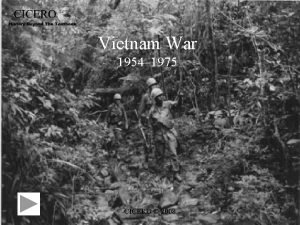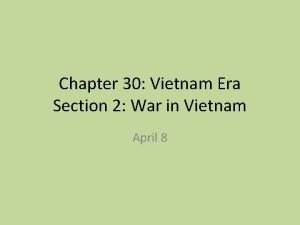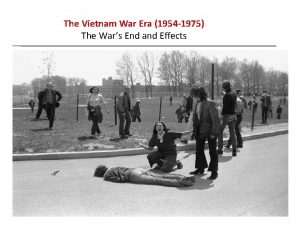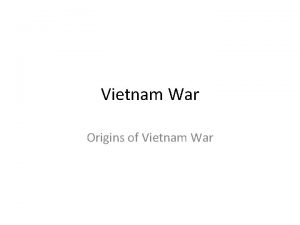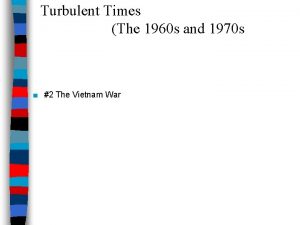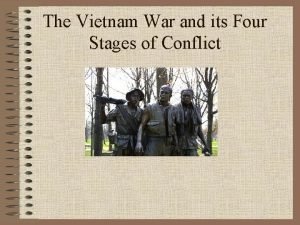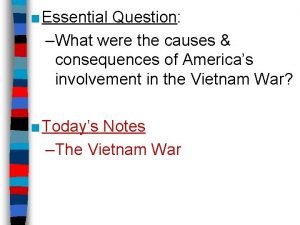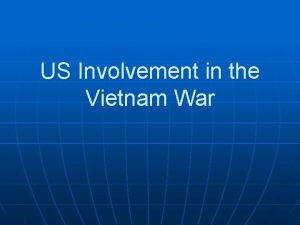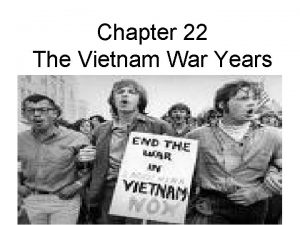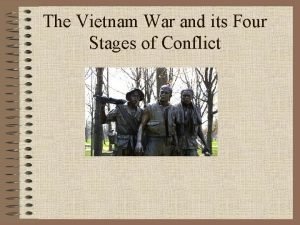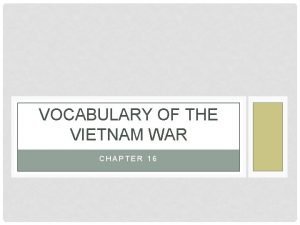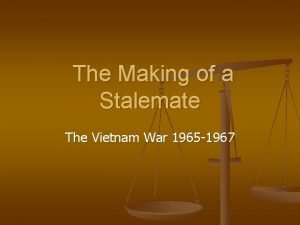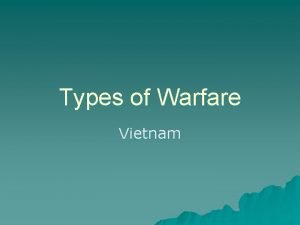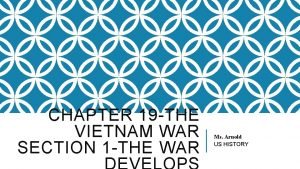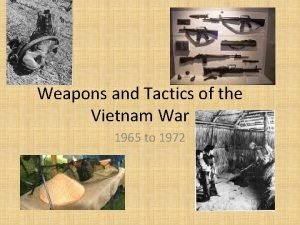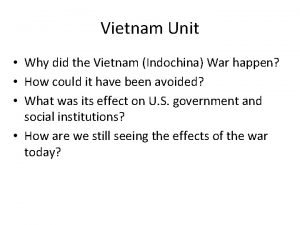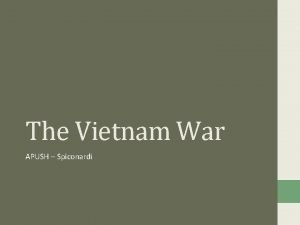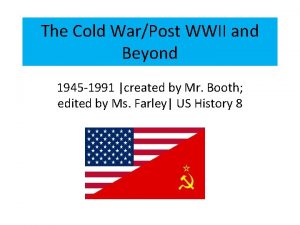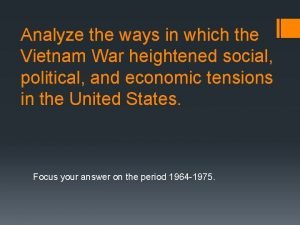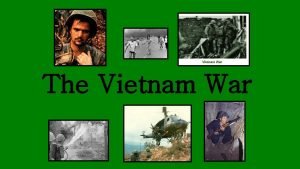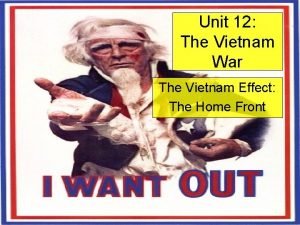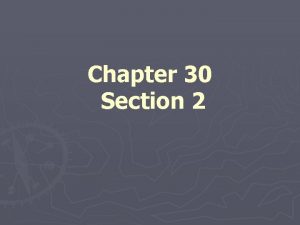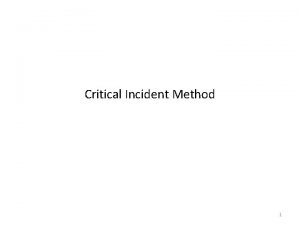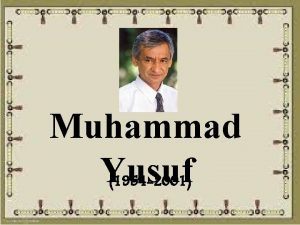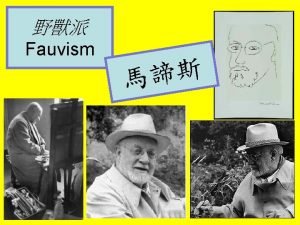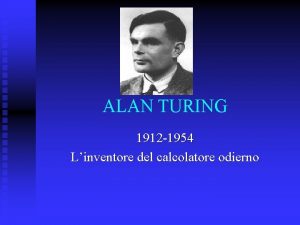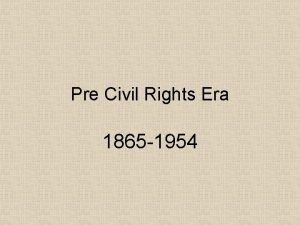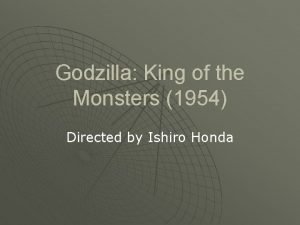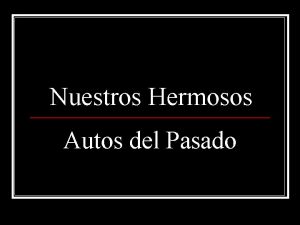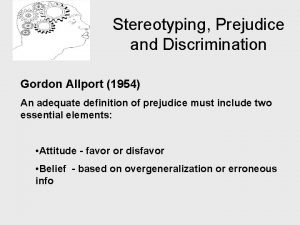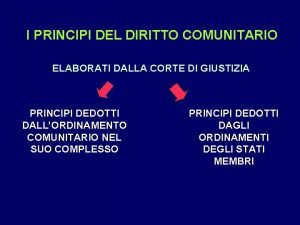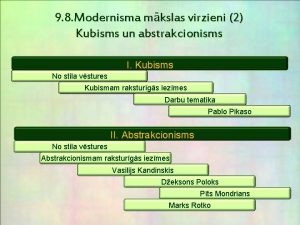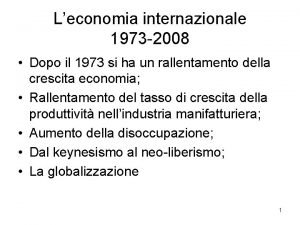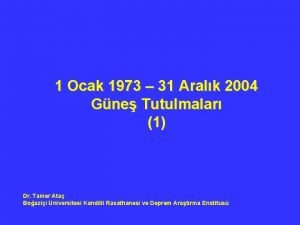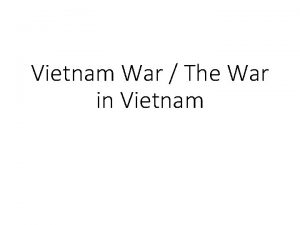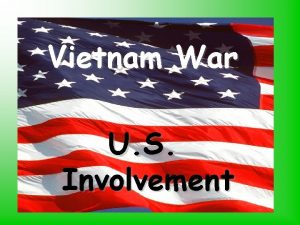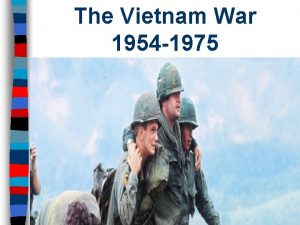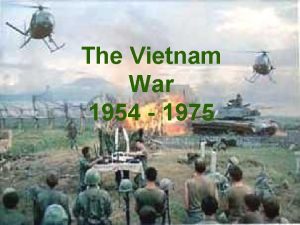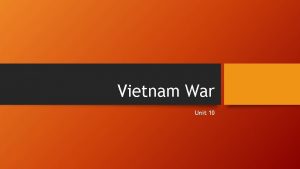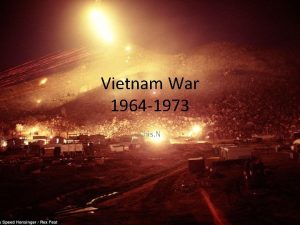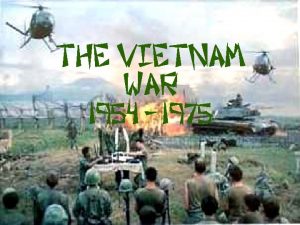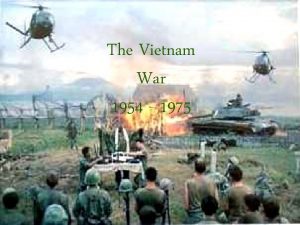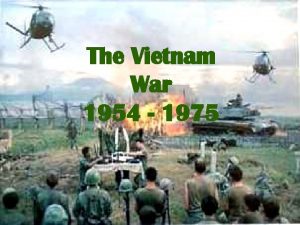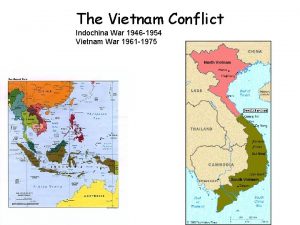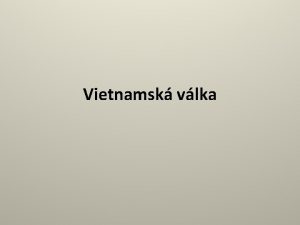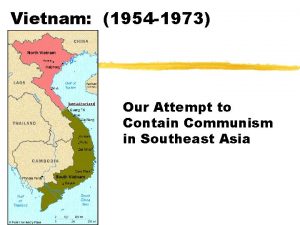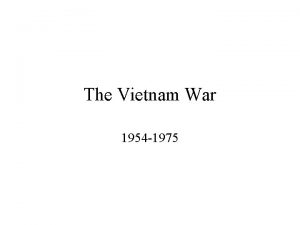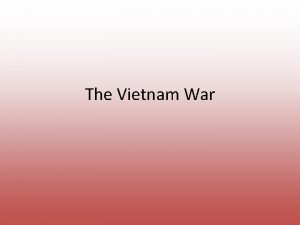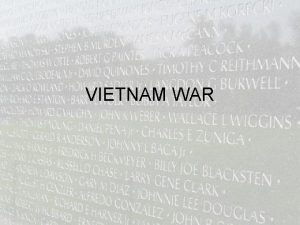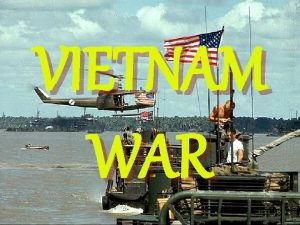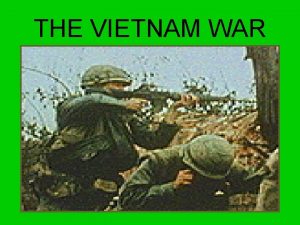The War in Vietnam 1954 1973 Vietnam had






















































- Slides: 54

The War in Vietnam 1954 -1973

• Vietnam had a 2000 year history of nationalism • Had consistently fought off Chinese invasions • Colonized by the French in the late 1800’s • Both France and Vietnam appealed to the US for help Background

• The Vietminh were led by Ho Chi Minh • The French were defeated at the siege of Dien Bien Phu in 1954 Ho Chi Minh • Vietnam was split until elections could be held.


• North Vietnamese Army (NVA) and Viet Cong (VC) vs. The Republic of Vietnam (RVA) and the US

US Involvement • Eisenhower begins to send “advisors” (500) • Kennedy increases this number (16000) • Johnson will GREATLY increase this number (536, 000 by 1968)

Containment • The United States would not openly confront Communist Russia, but would oppose the expansion of Soviet territory.

Domino Theory • If one falls, the rest will follow • This was our FIRM belief in the region (Appeasement!!!) • Johnson’s commitment



Gulf of Tonkin Resolution • Alleged attack on a US warship by Vietnamese patrol ships • LBJ used this to push the Gulf of Tonkin Resolution through Congress (416 to 0, 88 to 2) • Greatly expanded the President’s War Powers


Battlefield Conditions • Vs. guerilla warfare in the swamps and jungles

Viet Cong could retreat into Laos and Cambodia for protection

Vs. booby traps and land mines

Vs. the intricate tunnel system

• South Vietnamese government was corrupt, and did not help the war effort as much as it could have.


Toll on Civilians • Communist Brutality • Viet Cong Forces killed thousands of civilians as they were forced from cities

Massacre at My Lai • American forces killed 400 civilians who were suspected supporting the Viet Cong • American helicopter pilots helped to save many others

Intensifying The War • 1964 -1968 LBJ gradually steps up the war in terms on manpower and dollars

Ho Chi Minh Trail • Steady stream of supplies that moved through Laos and Cambodia • Caused LBJ to start bombing North Vietnam • US never stopped

Ho Chi Minh Trail

Ho Chi Minh Trail

Rolling Thunder • Nonstop, intensive bombing campaign of North Vietnam

Chemical Weapons and Defoliants were used (Agent Orange)


Napalm • Incendiary gel that burns in excess of 5, 000 Degrees used by the US Military in Vietnam. • Photos of burned civilians turned many Americans against the war.


Tet • 1/30/68 – series of surprise attacks all throughout South Vietnam • Viet Cong were turned back with very heavy losses • Government had been telling people that the North Vietnamese were on the verge of surrender

Effects of Tet • showed that the Viet Cong could still mount major offensive • images of fighting on American TV turned many against the war • led many to believe the war was unwinnable

Effects on LBJ’s Presidency • LBJ went from being a very popular president in 1963/1964, to one of the most unpopular by 1968. • Vietnam, in effect, wrecked his presidency.

Troop Levels in Vietnam • ESCALATION! • 1965 Beginning – 25, 000 End – 184, 000 • 1966 – 385, 000 • 1967 – 485, 000 • 1968 – 536, 000

Political Divisions • • Student Activism Baby Boomers Sit-ins, Teach-ins Free Speech Movements

Hawks and Doves Hawks supported the war in Vietnam, while doves opposed it.

Communes • Hippies would SOMETIMES live together, share common property, possessions, work, resources, and income. Far out, man!

Conscientious Objectors • Men and women who refused to serve, though some served in non-combat roles

• Resistance to the Vietnam War, and the draft for the War led to the formation of “The New Left” from Student Demonstration Groups

Students for a Democratic Society • “SDS groups” • Major college protest group • Organized protests among student groups • Protested against Vietnam War and “Oppressive Government”

Counterculture • Group whose norms are outside that of normal society. Examples include: Clothing, drugs, music, goals, and sexual practices.

Johnson Decides not to Run • Tet Offensive convinces Johnson that he cannot win the war, nor the election, seeks peace with North Vietnam • Johnson not running causes the Democratic Party to Split into several factions

The Election of 1968 • Democratic National Convention results in protest and rioting • Nixon tells America about his “Secret Plan” to win the war in Vietnam • Nixon Wins the Election

1968 1. Assassination of MLK 2. Tet Offensive 3. LBJ decides not to run for reelection 4. RFK is assassinated 5. Democratic National Convention / Election of 1968 6. Passage of the 26 th Amendment

The Last Years of the War 1968 • Nixon Elected • Paris peace talks begin

1969 • Nixon announces policy of “Vietnamization” • Formation of the “Weather Underground Terrorist Group

1969 - Woodstock • Massive 3 day concert that is seen as the highpoint of 1960’s music

1969 - Moon Landing • USA was challenged by JFK to make it to the moon by the end of the decade. • Landed July 20, 1969

1970 • Nixon calls for law and order • Appeals to the “Silent Majority” • Students killed while protesting at Kent State in OH, and Jackson State in MS

1971 • Nixon meets Elvis

1972 • Nixon Reelected • US troop levels in Vietnam fall to 24, 000 • North Vietnam renews attacks on South Vietnam • Nixon orders the most intensive bombing of the war

1973 • US troops are completely withdrawn from Vietnam.

1975 • Saigon falls to the North Vietnamese, the war is over

At Home - 58, 000 • US Soldiers were killed, 2500 were either POWs or MIAs. Many returning Vietnam Vets felt unappreciated. Ideas about the war left the country divided for years to come. Vietnam was the longest and least successful war in American history.

• South Vietnam falls to The North Vietnamese army in 1975. Millions of Vietnamese soldiers and civilians died in the war.
 Vietnam 1954
Vietnam 1954 Vietnam war
Vietnam war Comparing reconstruction plans venn diagram
Comparing reconstruction plans venn diagram Causes of the vietnam war
Causes of the vietnam war Effects of the vietnam war
Effects of the vietnam war The vietnam war
The vietnam war Vietnam war 1960
Vietnam war 1960 Stages of vietnam war
Stages of vietnam war What were the causes and effects of the vietnam war
What were the causes and effects of the vietnam war Vietnam
Vietnam The domino theory vietnam war
The domino theory vietnam war Stages of the vietnam war
Stages of the vietnam war Vietnam war
Vietnam war Vietnam war vocabulary
Vietnam war vocabulary Did the vietnam war end in a stalemate
Did the vietnam war end in a stalemate Punji trap victim
Punji trap victim Chapter 19 the vietnam war
Chapter 19 the vietnam war Us weapons vietnam war
Us weapons vietnam war Vietnam war massacre
Vietnam war massacre Operation rolling thunder cold war
Operation rolling thunder cold war Vietnam war apush
Vietnam war apush Vietnam war at home webquest answers
Vietnam war at home webquest answers Reason for vietnam war
Reason for vietnam war Analyze the ways in which the vietnam war heightened social
Analyze the ways in which the vietnam war heightened social Results of the vietnam war
Results of the vietnam war Vietnam
Vietnam Chapter 30
Chapter 30 Incident method
Incident method Muhammad yusuf uchrasharmidik
Muhammad yusuf uchrasharmidik Fortran
Fortran Henri matisse lydia delectorskaya
Henri matisse lydia delectorskaya Frida kahlo 1907 a 1954
Frida kahlo 1907 a 1954 1954
1954 1970-1954
1970-1954 1954 hemşirelik kanunu
1954 hemşirelik kanunu Ron hubbard 1954
Ron hubbard 1954 15 th ammendment
15 th ammendment Godzilla king of the monsters 1954
Godzilla king of the monsters 1954 Hurricane morgan 1954
Hurricane morgan 1954 Why is it coincidental that ruby was born in 1954?
Why is it coincidental that ruby was born in 1954? 1949 cadillac series 62 4 door
1949 cadillac series 62 4 door Magnétoscope 1954
Magnétoscope 1954 Fortran 1954
Fortran 1954 1954
1954 Allport 1954
Allport 1954 I have taken my breakfast
I have taken my breakfast L eat my breakfast
L eat my breakfast Wickens
Wickens Sentenza frontini 1973
Sentenza frontini 1973 1956-1973
1956-1973 1881-1973
1881-1973 Modernisma virzieni
Modernisma virzieni Kessie v charmant 1973
Kessie v charmant 1973 2008-1973
2008-1973 2004 tutulmalar
2004 tutulmalar
